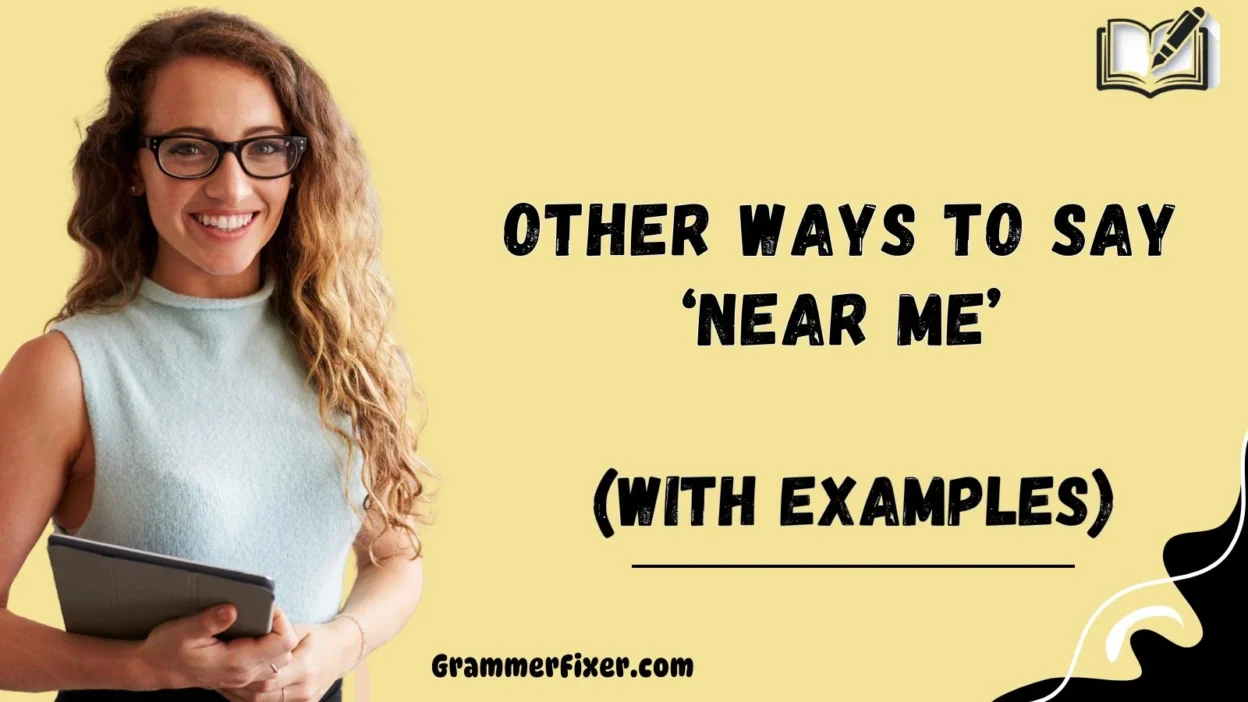Finding the right words can make even simple messages feel warm, thoughtful, and personal. When we communicate, phrases like “near me” can sometimes feel repetitive or bland. Using alternative expressions not only adds variety to your language but also makes your message feel more meaningful and engaging.
Below, we explore 30 alternative ways to say “near me”, complete with explanations, examples, and best-use scenarios to help you express yourself with care and clarity.
What Does “Near Me” Mean?
The phrase “near me” typically refers to something in close proximity to a person’s current location. It’s commonly used in both casual and formal contexts to indicate ease of access, convenience, or immediate surroundings.
When to Use “Near Me”?
Use “near me” when referring to locations, services, or activities that are easily reachable from your current position. Examples include asking for restaurants, stores, landmarks, or public facilities.
Is It Professional/Polite to Say “Near Me”?
Yes, “near me” is polite, neutral, and widely acceptable in most contexts—from casual conversations to formal writing or professional communication.
Pros and Cons of Using Alternatives to “Near Me”
Pros
- Adds variety and keeps language engaging.
- Allows tone flexibility: casual, friendly, or formal.
- Some alternatives are more precise for professional or technical use.
- Enhances storytelling and visual imagery.
- Improves audience engagement in writing or speech.
Cons
- Casual phrases may feel too informal in formal contexts.
- Some alternatives can be vague or confusing.
- Metaphorical phrases may mislead or confuse non-native speakers.
- Overuse can make text long or inconsistent.
- Idiomatic expressions may not work globally.
1. Close By
Meaning: Within a short distance from you.
Explanation: Often used to emphasize immediate accessibility.
Scenario Example: “There’s a café close by that serves great coffee.”
Best Use: Casual conversations, recommendations, directions.
Worst Use: In highly formal reports or legal documents—it may seem too informal.
Tone: Friendly, approachable.
2. Within Reach
Meaning: Easily accessible, can be reached without much effort.
Explanation: Highlights convenience and availability.
Scenario Example: “All the essentials are within reach in this neighborhood.”
Best Use: Lifestyle writing, casual advice, community guides.
Worst Use: Avoid in strict professional or technical writing where precision is required.
Tone: Supportive, practical.
3. Nearby
Meaning: Not far from the current location.
Explanation: Most versatile alternative, usable in almost any context.
Scenario Example: “There’s a bookstore nearby that has rare collections.”
Best Use: General directions, casual or professional settings.
Worst Use: In formal legal or highly technical documentation, where exact distance is required.
Tone: Neutral, informative.
4. Within Walking Distance
Meaning: Close enough to reach on foot.
Explanation: Emphasizes physical ease and comfort.
Scenario Example: “The hotel is within walking distance of Central Park.”
Best Use: Travel blogs, city guides, casual recommendations.
Worst Use: In situations where driving or transport details are crucial, as it may mislead.
Tone: Friendly, practical.
5. Just Around the Corner
Meaning: Very close, usually within sight or a short walk.
Explanation: Adds a playful or cozy tone.
Scenario Example: “The bakery is just around the corner.”
Best Use: Conversational writing, casual guides.
Worst Use: In professional reports, maps, or technical descriptions—it’s too informal and imprecise.
Tone: Warm, inviting.
6. In My Vicinity
Meaning: Located in the surrounding area.
Explanation: Slightly formal, useful in professional or official contexts.
Scenario Example: “We offer several clinics in your vicinity.”
Best Use: Professional communication, medical or service contexts.
Worst Use: Casual chats with friends—it can sound unnecessarily formal or stiff.
Tone: Neutral, formal.
7. A Stone’s Throw Away
Meaning: Extremely close, within a very short distance.
Explanation: Metaphorical, implies effortless access.
Scenario Example: “The museum is just a stone’s throw away from the hotel.”
Best Use: Travel guides, storytelling, conversational writing.
Worst Use: Academic or professional reports—it’s figurative and may reduce clarity.
Tone: Playful, visual.
8. Adjacent
Meaning: Directly next to or beside something.
Explanation: Professional, precise, often used in formal reports or real estate descriptions.
Scenario Example: “The office building is adjacent to the main street.”
Best Use: Academic, legal, real estate writing.
Worst Use: Casual conversations with friends—it can sound overly technical or stiff.
Tone: Formal, precise.
9. In the Neighborhood
Meaning: Within the local residential or community area.
Explanation: Emphasizes community and belonging.
Scenario Example: “There’s a cozy café in the neighborhood.”
Best Use: Lifestyle blogs, friendly recommendations, community-focused content.
Worst Use: Professional reports or precise location instructions—it’s too general.
Tone: Warm, approachable.
10. Next To
Meaning: Directly beside something.
Explanation: Simple, clear, and visual.
Scenario Example: “The sushi bar is next to the main street.”
Best Use: Directions, casual or professional writing.
Worst Use: Avoid in descriptive academic or formal texts where exact distance or orientation is needed.
Tone: Neutral, informative.
11. Immediate Area
Meaning: Surrounding area right around your location.
Explanation: Often used in technical or formal contexts.
Scenario Example: “We have several parking lots in the immediate area.”
Best Use: Reports, professional documents, signage.
Worst Use: Casual conversations—it may sound too stiff or bureaucratic.
Tone: Professional, precise.
12. Within Proximity
Meaning: Close enough to reach easily.
Explanation: More technical and precise than “near me,” commonly used in professional or academic contexts.
Scenario Example: “All emergency exits are within proximity of the main hall.”
Best Use: Professional reports, academic papers, technical guides.
Worst Use: Informal chats or casual texts—it can seem unnatural.
Tone: Formal, clear.
13. Around
Meaning: Close in general area, not exact.
Explanation: Casual, versatile, and widely understood.
Scenario Example: “There’s a café around here that serves vegan snacks.”
Best Use: Casual directions, informal writing, storytelling.
Worst Use: Situations requiring exact or technical location—it’s too vague.
Tone: Friendly, conversational.
14. Just Nearby
Meaning: Very close in distance.
Explanation: Simple and approachable, emphasizing convenience and ease of access.
Scenario Example: “The library is just nearby, so we can walk there.”
Best Use: Everyday conversations, casual writing.
Worst Use: Technical reports or legal documents—it lacks precision.
Tone: Friendly, approachable.
15. Around the Corner
Meaning: Extremely close, often just out of sight.
Explanation: Informal, metaphorical, evokes a sense of coziness or playfulness.
Scenario Example: “The little bakery is around the corner from the park.”
Best Use: Casual conversation, lifestyle blogs, travel guides.
Worst Use: Professional reports or legal documents—it’s too figurative.
Tone: Warm, playful.
16. Beside
Meaning: Directly next to something.
Explanation: Very precise, visually descriptive, and easy to understand.
Scenario Example: “The coffee shop is beside the bookstore.”
Best Use: Directions, casual or semi-formal writing.
Worst Use: Avoid in technical or professional documents needing formal terminology like “adjacent.”
Tone: Neutral, simple.
17. Within Driving Distance
Meaning: Close enough to reach by car within a short time.
Explanation: Emphasizes accessibility by vehicle rather than walking.
Scenario Example: “The zoo is within driving distance from downtown.”
Best Use: Travel guides, city planning, casual recommendations.
Worst Use: Overused in local-only contexts where walking or public transport is standard—it can mislead.
Tone: Informative, practical.
18. Nearby Area
Meaning: General area surrounding a location.
Explanation: Neutral, works in both casual and professional contexts.
Scenario Example: “There are several parks in the nearby area.”
Best Use: Community newsletters, general directions.
Worst Use: Academic or precise professional writing—it’s too vague for technical purposes.
Tone: Neutral, versatile.
19. Close At Hand
Meaning: Easily accessible, immediately available.
Explanation: Slightly idiomatic, emphasizes readiness and convenience.
Scenario Example: “Snacks and drinks are close at hand in the lounge.”
Best Use: Informal or friendly writing, hospitality contexts.
Worst Use: Avoid in technical or legal reports—it may appear too casual or literary.
Tone: Friendly, conversational.
20. In Proximity
Meaning: Close, nearby, or within measurable distance.
Explanation: Formal, precise, suitable for academic, professional, or technical contexts.
Scenario Example: “Hospitals are in proximity to major highways for easy access.”
Best Use: Professional reports, real estate, academic writing.
Worst Use: Casual conversation—it can sound overly stiff.
Tone: Formal, precise.
21. Within the Vicinity
Meaning: Located in the general area.
Explanation: Polite and slightly formal, suitable for both professional and neutral contexts.
Scenario Example: “There are several clinics within the vicinity of your location.”
Best Use: Professional emails, community notices.
Worst Use: Casual texting—it may sound unnecessarily formal.
Tone: Polite, neutral.
22. Immediately Around
Meaning: Directly surrounding, very close.
Explanation: Highlights direct accessibility, often used in directions or guides.
Scenario Example: “Parking is available immediately around the building.”
Best Use: Maps, directions, travel guides.
Worst Use: Informal chats—it may sound awkward or overly descriptive.
Tone: Informative, precise.
23. Close to Me
Meaning: Near your current location.
Explanation: Direct, casual, widely used in spoken English.
Scenario Example: “Do you know a good café close to me?”
Best Use: Daily conversations, app searches, informal writing.
Worst Use: Professional or academic writing—it’s too casual.
Tone: Friendly, conversational.
24. Within Easy Reach
Meaning: Easily accessible, requiring minimal effort.
Explanation: Emphasizes convenience and simplicity.
Scenario Example: “The hotel amenities are within easy reach.”
Best Use: Travel writing, lifestyle blogs, casual directions.
Worst Use: Formal reports or technical writing—it’s idiomatic and informal.
Tone: Supportive, friendly.
25. Just a Step Away
Meaning: Extremely close, within minimal effort to reach.
Explanation: Metaphorical, emphasizes immediacy and convenience.
Scenario Example: “The bakery is just a step away from the park entrance.”
Best Use: Casual conversations, travel blogs, storytelling.
Worst Use: Academic, legal, or highly professional writing—it’s too informal.
Tone: Warm, playful.
26. In the Same Area
Meaning: Located within the same general vicinity.
Explanation: Neutral and descriptive, good for both casual and semi-formal contexts.
Scenario Example: “There are several cafés in the same area as the library.”
Best Use: Community newsletters, travel guides, casual directions.
Worst Use: Formal reports or technical documents—it lacks precise measurement.
Tone: Neutral, approachable.
27. In Close Proximity
Meaning: Very near, within measurable closeness.
Explanation: Professional, precise, suitable for technical, academic, or real estate contexts.
Scenario Example: “Schools are in close proximity to the residential area.”
Best Use: Reports, professional documents, real estate listings.
Worst Use: Casual conversation—it may sound overly formal.
Tone: Formal, precise.
28. Along the Road
Meaning: Positioned on or beside a road nearby.
Explanation: Directional and practical, emphasizes accessibility.
Scenario Example: “There’s a gas station along the road before the turn.”
Best Use: Travel guides, driving directions, casual information.
Worst Use: Academic or highly formal writing—it’s too casual.
Tone: Informative, practical.
29. Just Around
Meaning: Very close, within short distance.
Explanation: Casual, easy to understand, metaphorical.
Scenario Example: “There’s a cozy café just around from here.”
Best Use: Casual directions, conversational writing, storytelling.
Worst Use: Formal or technical reports—it’s imprecise.
Tone: Friendly, approachable.
30. Within the Surroundings
Meaning: Located in the nearby environment or area.
Explanation: Slightly formal, descriptive, good for professional or academic contexts.
Scenario Example: “The playground is safe and well-maintained within the surroundings of the school.”
Best Use: Professional or semi-formal descriptions, real estate, community guides.
Worst Use: Casual conversation—it may sound stiff or overly technical.
Tone: Formal, descriptive.
Conclusion
Finding the perfect way to express “near me” can make your communication feel more thoughtful, personal, and precise. While the phrase itself is simple and widely understood, exploring alternative expressions allows you to adapt your tone to suit different contexts—whether friendly, playful, professional, or formal.



